False advertising 101.
So, I went to some fast food places… I won't say "restaurants", just "places". After a lifetime of disappointment, bafflement, and rage, I decided it was time to do a little test, and compare the food you get with the ads. (I'm always on the hunt for little projects like this. Stoked.) I brought the food home, tossed it into my photography studio, and did ad-style shoots, with pictures of the official ads on my computer next to me, so I could match the lighting and angles.
-
People around the world know fast food as one of the most reliable distributors of disappointment ever produced by the business world. We know that if we ever feel the need to complain about something, we can just grab a page out of a coupon booklet, adorned in pictures of juicy burgers, then go have a party. Why, the places themselves usually plaster their walls with pictures of juicy burgers – often hanging right over your table – so that you need only open your eyes to find something to compare your food with.
Needless to say, the results of my project were unsurprising… which shouldn't be a surprise.
The Rules:
1 – I only care about size. I don't care if my lettuce isn't arranged like the crown on Caesar's head.
2 – I have to show the most attractive angles of the food, with lighting identical to the ads.
Note: This is an ongoing project, started late 2010. It's free to spread around, and repost anywhere, without permission.

The taco on the right is my life experience with Taco Bell. (best of two tacos that I bought)
Once upon a time, occasionally dropping in to Taco Bell was something I did, and I always held this grudge: I said, "If you have a company called TACO Bell… and you have this item on your menu called "Crunchy Taco" – you know, like your flagship item – let us hope to heaven up high that it doesn't look like THIS." (Seriously… we've got 3 ingredients in here: lettuce, cheese, and meat somewhere.)
Since these tacos are pretty dry and empty, I can only tolerate them with hot sauce, which, for me, is when they become good.

(The tacos come in 2.)
I picked these up at a location about half an hour from Jack In The Box's corporate headquarters. Since I'm showing the largest tacos I could get, I can't show you how they like to seal themselves shut, like a clam, so that you can't even see inside. The cheese acts as a perfect glue at the edges. I swear, if you had to use one as a snorkel, to save your life, you would not get air.
They taste a lot better than they look, but that's because I don't actually think they're tacos; they're just tragically mis-shaped and misrepresented nacho pockets (or something). Pitching them as tacos is a crime against humanity, because we humans have standards of what a taco should look like. And not seal itself shut like.

Burger King has had this a long time coming. The Whopper I got the other night was a sight to behold. On one hand, it was exactly the size I remember them being, but it might've been the most uninspiring Whopper I've ever seen in my life. I'm certain it was just a collection of all the disappointment Burger King has ever served, manifest into a curse, which was now coming back to haunt them.
Okay, let's give Burger King one more chance here…

They need to fire the guy who does his yoga on top of the Whoppers.
I had a childhood of eating these, during the 99-cent Whopper sales they used to have. Mine here was $3.69. (They have the nerve to charge extra for cheese. Maybe they should consider charging extra for things when they decide to serve even half a Whopper.)
…while I was at it, I caught sight of a gargantuan Whopper Jr. photo on the menu, and couldn't resist:

"Get your burger's worth," eh, Burger King? (That was their slogan for a while.)
—
Before we continue, there's something everyone should understand: burger size/presentation can certainly vary from location to location, even if we know that it usually isn't by much. But, for example, when I was young, I once went to a Burger King right next to the beach, where I got a Whopper that was comparatively huge… and it had toasted buns. I never forgot that… though I later speculated it was probably because California is known for its great beach-side burger shops (REAL places), so, being next to the beach, this place had to compete.
MY nearest two locations, however, have issues. This is what I got when I asked them specifically for burgers as big as the ads:

(The one in the middle has cheese. I forgot cheese on the other one.)
A fast food place can't flatly turn down a request for a burger as big as the ads. They can't say, "I'm sorry, we aren't able to make burgers that big."… so, I wanted to see if my two nearest locations would even try. For both orders, I (very politely) asked if my Whopper could be made exactly as big as the ones right behind the cashier, on the menu. Both times, the cashiers turned and took strangely long, careful looks, as if nobody had ever requested that before. They said sure.
Well… I like the pile of onions I got with the second one.
(Note: I'm sure you can find some location where they'll at least TRY. Surely, it's just a matter of getting the right people… but, considering that my first two tries were misfires, I wonder exactly what the ratio is between employees who will try, and ones who won't. Employee training seems to teach absolutely no concept of preparing inviting food.)
-
Back to price… things always get worse at McDonald$:

$4 now will get you one of these. ($3.99, to be exact, but that 99 is psychology that I think should be illegal.)
The size was pretty close to the ad… though I'm still trying to determine the planetary origins of this lettuce:

(That's actually a pickle in the upper right.)
For those who don't know, Big Macs come in a little box. Looking down in the box, and lifting the top bun, you ask yourself, "What is this empty, dry thing?" Apple fans know of Apple's famous "unboxing experience" – when you open the gloriously friendly, won't-destroy-your-hands packaging of an iPhone/iPad/etc – but, well, Big Macs are still working on theirs. They should come with little pink, polka-dotted bow-ties, or little top-hats… and, given the price, they should be made out of real fur.
Big Macs taste really good, though, at least to me… even coming out of the fridge, the next day. In comparison, a leftover Whopper, coming out of the fridge like a mushy old sock from a trash bin, is a different story.
-
After a little thinking, I realized something. I thought, "You know, these Big Macs I got seem to fit in the boxes pretty snugly… as if the boxes were designed ONLY to house the actual, served Big Macs. I wonder if the advertised ones would even fit." So, I did a test:
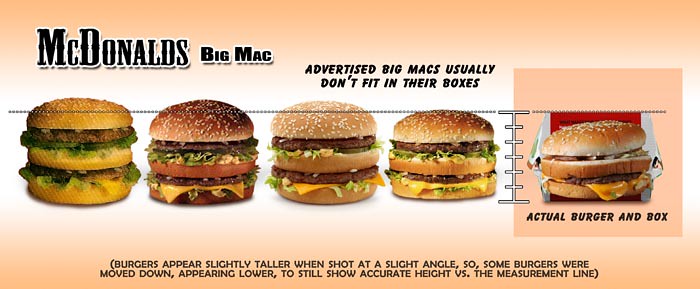
Oops.
My measurements are unscientific, but extremely carefully done, so I certainly hold my candle to them.
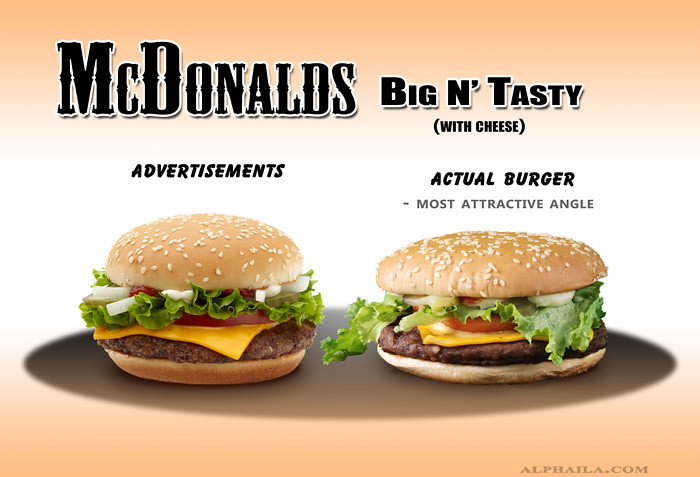


One of the burgers performed! The burger I got looks even more serious than the ad.
I got mine with cheese. It cost $4, or $3.79 without cheese.
Looking at the burger I got gives me this weird feeling, though, like the ad should have looked like this:
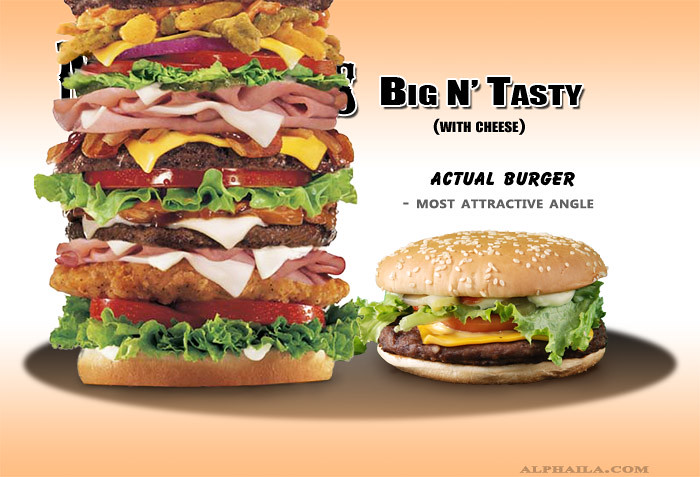
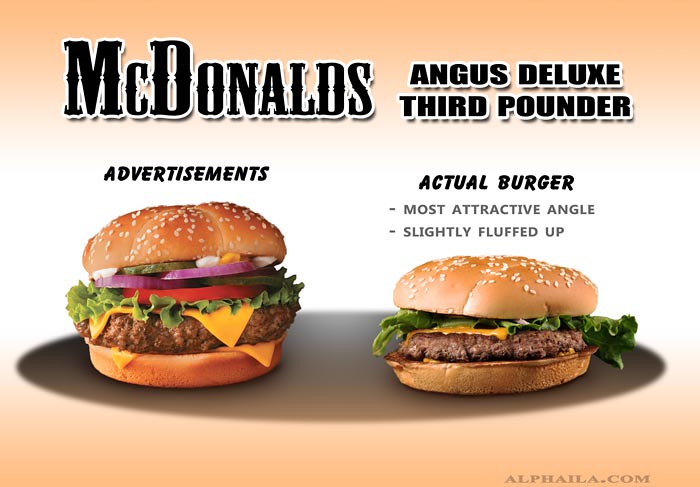
Another $4 burger (mine was $4.29, plus tax)…
Well, I really liked the lettuce I got with this one. You'll certainly never see a Whopper or Big Mac with that kind of lettuce. But WHAT HAPPENED TO THE MEAT?! It seems to be on a diet, whereas the ad's meat was only missing a cowbell…
Flavor-wise, for me, it's a terribly boring burger. There are many $1 burgers that I prefer over this. When trying to figure out what keeps these on the menu, at least for this price, I think either some people out there really like them, or they sell as one-time-buys, intended for people who drop in late one night, and are deceived by the juicy picture… (and have a LOT of money).
-
This one also comes in a box (a wider, bigger box than the Big Mac), so, I had to test again:
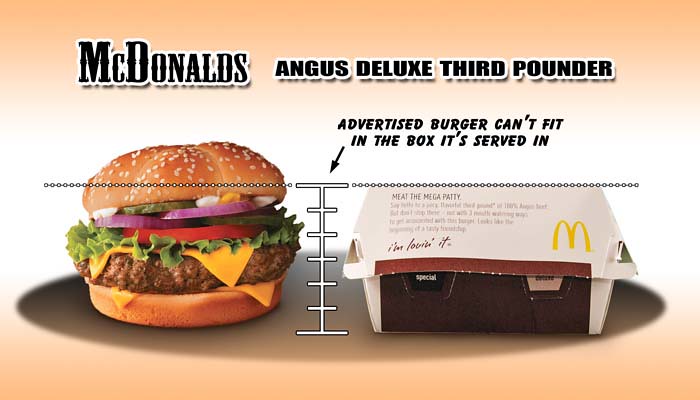
I hope McDonald's does something about this. What I think we learn here is that some of their burgers not only don't look like the ads, but physically CAN'T.
I'm wondering if the other Third Pounder burgers don't fit in the boxes, and, for that matter, if there are other ways to show similar flaws. Examples I have in mind:
- Are some wrappers too small to fit ad-sized burgers? Could they simply not be closed?
- I'm fairly certain that many ad shots have all of the ingredients crammed up in the front. Should it be legal to do this, if the human mind perceives that the thickness seen in front must be wrapping around the entire burger, equally?
- Should you be able to call the "Third Pounders" that name if it's only a third pound of meat while frozen, not when it's served to you? When buying meat, it makes sense to see the pre-cooked weight, because you mentally classify that differently… but, when you're being served something off a menu, if they say you're getting a "third pound" of meat, who actually knows that they're talking about the meat before it was cooked? Realize that shopping at any store that isn't a restaurant ALWAYS has this "rule": the weight tells you what you're GETTING… not what it used to be. For instance, when you're at a grocery store, all vegetables, fruit, MEAT, cereal, pasta, and everything else is labeled with the weight you're GETTING. Restaurants are the ONLY places that reverse this rule, and it's only done for meat. Ever notice that? Restaurant menus often have pictures of their items, with taglines like, "A half pound salad," or, "Served with a quarter pound of ice cream,"… because that's what you're getting. When you're about to buy a pound of fresh cheese, they don't mention the cheese's weight in milk. Even things that change while cooking, like bread, aren't listed by their weight in dough. 2 points: 1) Cooked meat is the only thing that does this. 2) Never in my life did I buy a burger with a quarter-pound of meat thinking I would end up with half of that.
- Anything else? Please chime in here.
Don't ask me how this advertising is legal. I think the law for this stuff should take into account things like the "innards-to-bun ratio"… in other words, if the ads show 70% innards, 30% buns, the real thing can't be 10% innards, 90% buns. Better yet, what if advertising had to be able to stand up to an ordinary group of people, who could decide if something seemed to them like it was a flat-out lie?
It seems that the law – at least in the US – is often designed only to appease the God of Plausibility, completely ignoring the way the human mind naturally judges correctness. Understand that there are several different types of correctness… and we'll see which ones are being met here:
Technical correctness
This is what is ACTUALLY correct, whether a person can perceive it or not. Probably 99.99% of fast food locations won't serve you a burger that is technically as big as the ads… therefore, there's virtually no technical correctness here.
Perceptual correctness
This is what people naturally perceive as being correct. In fact, it's most often the only form of correctness that has any meaning to us at all. Fast food ads are almost never perceptually correct. When does someone look at a fast food ad, and think it's anything but a lie?
Plausible correctness (or occasional correctness)
Plausible correctness works like this: If even one fast food location COULD, in theory, serve you a burger the size of the ads, then,plausibly, the portrayal in the ads is correct… because there's no natural force stopping a burger from turning out as big as in the ads, so, one COULD turn out that big. It could be argued that plausible correctness isn't a form of correctness at all… rather, it's just overemphasizing the possibility that, given infinite time, correctness could eventually occur. – Have you ever heard the saying, "Given infinite time, a group of monkeys banging on keyboards would eventually type out the complete works of Shakespeare." It almost seems like fast food advertising is allowed because, given infinite time, a fast food place might eventually produce a burger as big as the ads.
I think plausible correctness is the only one being met here. The God of Plausibility may reign over all advertising law, but we human beings simply don't subscribe to his plausible glory. This setup is bothersome because, if you think about it, it's literally like letting companies put a picture of Cheerios on a box of Corn Flakes, because, on occasion, you get a Corn Flake shaped like a Cheerio.
Whatever the case, I happily pitch the idea that lawmakers are committing a crime against us people by allowing us to be continually insulted by this advertising, and consequently this pursuit of plausible correctness. It's all done in extreme defiance of human perception, as the other two forms of correctness are the only ones that our minds are designed to tolerate at all.
-
Why do advertising laws seem to completely ignore this? Fast food advertising is a cultural disaster, which affects our entire perception of what commercialism means, and what kind of fiber our society is made of. Maybe lawmakers think that passing stricter laws would result in some markets having reduced sales. I don't think it would be as many as you think, because most companies may polish their products for pictures, but not inflate them to the moon. Just think about the consequences of this advertising: It probably helps ALL people to have a poor regard for society and business as a whole, and the meaning of all commercialism. How are people supposed to be engaged in society if they hate what it represents? How will kids get the inspiration to start a business one day, if the idea of business sickens them?
There are probably many reasons that people have skepticism toward commercialism, and the leaning of society as a whole, but I think insane advertising is a powerful one. Nowadays, advertising is the team jersey that a country wears. It's the game face of modern society, and the banner under which all the economy marches. If it happens to feel repulsive and in really bad taste, good luck having people that care about society or the world.
_________________________________________________________________________________________________________
Studio Setup

I used a greenscreen, a rotating chair, and three wireless flashes (often only firing two). My camera is a Nikon D80…

This is what the original shots looked like…
(this is the Big Mac I got when I did the box test. Most attractive angle.)

Behind me was this computer, where I had the ad shots on the screens…


I also shot this Jack In The Box "Jumbo Jack" (their flagship burger – attractive angle on the left). However, I decided to only give limited attention to US-only fast food chains. (In fact, many parts of the US don't even have Jack In The Box).
I also badly wanted to cover Carl's Jr. (aka Hardee's) – the eternal gods of false advertising – but, when thinking globally, they're just too little of a chain, so, it would waste the time of lots of readers. But try to imagine my enthusiasm here: much of my drive to do this project came specifically from my childhood years of watching Carl's Jr. commercials. Observe:
_________________________________________________________________________________________________________
In all cases, I gave the items as fair a chance as absolutely possible, though I didn't take the time to buy multiples of everything…whether that would've been to choose the best stuff I could find, or pick out an average. Though, you know, ALL the Whoppers really are from Hell. I want to leave them as-is, just so the Burger King people can enjoy a little, what, maybe disappointment?







































